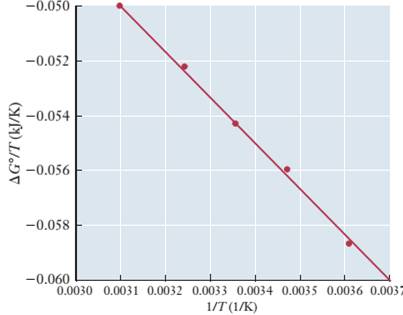
10.85 Iodine is not very soluble in water, but it dissolves readily in a solution containing iodide ions by the following reaction:
The following graph shows the results of a study of the temperature dependence of
(a) Calculate
(b) Determine
. It may help if you realize that the graph is a straight line and then try to write an equation for that line
Trending nowThis is a popular solution!

Chapter 10 Solutions
Chemistry for Engineering Students
- Indicate which one of the following reactions most certainly results in a negative AS sys. O1402(g) + 3NH4NO3 (s) + C10 H22(1) → 3N2(g) + 17H2O(g) + 10CO2(g) ○ CO2(aq) = CO2(g) ○ H₂O(g) = H₂O(s) CaCO3(g) = CaO(s) + CO2(g) O CuSO4.5H2O(s) = CuSO4(s) + 5H2O(g)arrow_forwardEstimate the DH°rxn of the reaction below: H H-C-C=C-H H Н A table of bond energy Bond H Bond Energy (kJ/mol) C-H 413 C-O 360 C=O 743 C-C 348 |C = C 612 O-H 463 H-H 436 + H-H -> H H-C. - H | | 1 HHHarrow_forwardShow work...don't give Ai generated solutionarrow_forward
- Given the standard enthalpies of formation for the following substances, determine the reaction enthalpy for the following reaction. 3A(g) + 1B (g) 4C (g) + 7D (g) Substance AH in kJ/mol A (g) - 25.07 B (g) - 36.51 C (g) - 90.09 D (g) + 56.11 AHran =?kJarrow_forwardWhat is the change in internal energy (ΔU) when a system is heated with 42.0 J of energy while it does 110.0 J of work?arrow_forwardCan you help me solve this problem and explain what the answers are?arrow_forward
- For which reaction below does the enthalpy change under standard conditions correspond to a standard enthalpy of formation? (Choose all that applies) SO2(g) + 1/2 O2(g) → SO3(g) 2H2(g) + C(s) → CH4(g) Mg(s) + 1/2 O2(g) → MgO(s) CO(g) + H2O(g) → CO2(g) + H2(g) CO2(g) + H2(g) → CO(g) + H2O(g) 1/2 H2(g) + 1/2 N2(g) + 3/2 O2(g) → HNO3(g) CO2(g) + C(s) 2CO(g) N2(g) + 202(g) → 2NO2(g)arrow_forwardChoose all the molecules with zero standard-enthalpy-of-formation (AH% = 0) Fe(s) FeCl2(s) N2(g) H2O(l) 02(g) C(graphite) K(s) H2O(g)arrow_forward8.5 g of potassium hydroxide (molar mass = 56.1 g/mol) dissolves in 125 g of water and the temperature of the solution increases by 15.58°C. Calculate the AH soln for potassium hydroxide. Assume the specific heat capacity of the solution is 4.2 J.g¨¹.ºC-1. KOH(s) → →K+ K(aq) + OH AH solution = ?kJ/mol (aq)arrow_forward
- What will be the final temperature of a 8.79 g piece of iron (CP = 25.09 J/(mol · oC)) initially at 25.0oC, if it is supplied with 302.8 J from a stove?arrow_forwardIdentify the set of stoichiometric coefficients that balances the reaction equation for the combustion of the hydrocarbon below: _ C19 H4002 → CO2 + H2Oarrow_forwardThe cooling system in an automobile holds 11.3 L of ethylene glycol antifreeze. How much energy is absorbed when the temperature of the ethylene glycol goes from 20oC to 100oC? The density and specific heat capacity of ethylene glycol are 1.11 g/mL and 2.42 J/(g ⋅ oC), respectively.arrow_forward
 General Chemistry - Standalone book (MindTap Cour...ChemistryISBN:9781305580343Author:Steven D. Gammon, Ebbing, Darrell Ebbing, Steven D., Darrell; Gammon, Darrell Ebbing; Steven D. Gammon, Darrell D.; Gammon, Ebbing; Steven D. Gammon; DarrellPublisher:Cengage Learning
General Chemistry - Standalone book (MindTap Cour...ChemistryISBN:9781305580343Author:Steven D. Gammon, Ebbing, Darrell Ebbing, Steven D., Darrell; Gammon, Darrell Ebbing; Steven D. Gammon, Darrell D.; Gammon, Ebbing; Steven D. Gammon; DarrellPublisher:Cengage Learning Chemistry & Chemical ReactivityChemistryISBN:9781337399074Author:John C. Kotz, Paul M. Treichel, John Townsend, David TreichelPublisher:Cengage Learning
Chemistry & Chemical ReactivityChemistryISBN:9781337399074Author:John C. Kotz, Paul M. Treichel, John Townsend, David TreichelPublisher:Cengage Learning ChemistryChemistryISBN:9781305957404Author:Steven S. Zumdahl, Susan A. Zumdahl, Donald J. DeCostePublisher:Cengage Learning
ChemistryChemistryISBN:9781305957404Author:Steven S. Zumdahl, Susan A. Zumdahl, Donald J. DeCostePublisher:Cengage Learning Chemistry: An Atoms First ApproachChemistryISBN:9781305079243Author:Steven S. Zumdahl, Susan A. ZumdahlPublisher:Cengage Learning
Chemistry: An Atoms First ApproachChemistryISBN:9781305079243Author:Steven S. Zumdahl, Susan A. ZumdahlPublisher:Cengage Learning
 Principles of Modern ChemistryChemistryISBN:9781305079113Author:David W. Oxtoby, H. Pat Gillis, Laurie J. ButlerPublisher:Cengage Learning
Principles of Modern ChemistryChemistryISBN:9781305079113Author:David W. Oxtoby, H. Pat Gillis, Laurie J. ButlerPublisher:Cengage Learning





